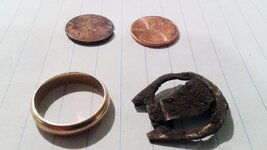I remember being in a nice little shop run by George in Edwardsville PA. A women was asking about the secrets of metal detectors finding gold jewelry. At that point, George asked her for her gold ring and waived it over the coli of a metered machine. He said, "This is tin." The look on her face was priceless as she responded with utter shock and said, "This ring is 14 karat gold!" She missed the point.
Well truthfully, there isn't any secrets and if anyone says they have one, I would be very skeptical. There are however some pointers that you can use as a guide to help increase your chances of find gold jewelry.
Good solid two way hit with stable TID(Target ID). I haven't dug much gold jewelry, but all the ones I did, had a stable TID from all angles. However, there are some accounts I read, where there were other factors and the target was a jumpy garbage sounding target.
Go where the gold is! If you are at a public park, you may find a few pieces of gold jewelry. However, at the beach or swimming area is where your best chance is. That is because of the skin shrinking making lose fitting jewelry fall off.
Focus and dig. if you are trying to find everything under the sun, it takes your focus away from jewelry. Try it just one time. Block out everything but the gold range and dig those targets.
Get used to what your machine is telling you. I have a ctx 3030 and I can tell "beaver tails" by the strength, depth and TID. Anyone one of those factors singularly will not give you the whole story.
I hope this helps!
Good luck and HH!
Well truthfully, there isn't any secrets and if anyone says they have one, I would be very skeptical. There are however some pointers that you can use as a guide to help increase your chances of find gold jewelry.
Good solid two way hit with stable TID(Target ID). I haven't dug much gold jewelry, but all the ones I did, had a stable TID from all angles. However, there are some accounts I read, where there were other factors and the target was a jumpy garbage sounding target.
Go where the gold is! If you are at a public park, you may find a few pieces of gold jewelry. However, at the beach or swimming area is where your best chance is. That is because of the skin shrinking making lose fitting jewelry fall off.
Focus and dig. if you are trying to find everything under the sun, it takes your focus away from jewelry. Try it just one time. Block out everything but the gold range and dig those targets.
Get used to what your machine is telling you. I have a ctx 3030 and I can tell "beaver tails" by the strength, depth and TID. Anyone one of those factors singularly will not give you the whole story.
I hope this helps!
Good luck and HH!











